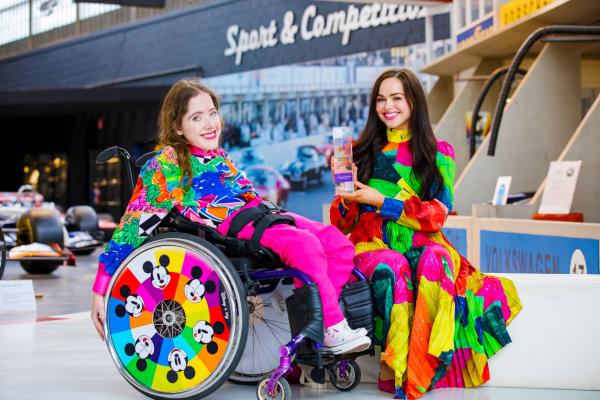Whether manual or electric powered, wheelchairs have undoubtedly improved the lives of millions of people who have difficulties in walking. Today, the same digital technologies that are changing the way we live, work, get around and interact – artificial intelligence, 3D printing, internet of things, voice activation – are also being applied to the wheelchair industry.‘There is a lot of research now that demonstrates how state-of-the-art technology can enable disabled persons become more independent,’ said Manuel Lai, co-founder of IRIS, a leading SME specialised in developing innovative technologies.This is good news for those with reduced mobility, especially if living in urban centres. Despite many important advancements over the past decade, mobility challenges continue to prevent disabled persons from participating in society on equal terms.A self-driving pay-as-you-use approach‘We need mobility solutions for disabled and elderly people that promote their social inclusion in urban environments and allow them to move around easily without the need for help,’ said Lai.As coordinator of theFreeWheelproject, he spent more than a year studying the needs and requirements of wheelchair users, developing a solution designed specifically for urban environments.“We need mobility solutions for disabled and elderly people that promote their social inclusion in urban environments and allow them to move around easily without the need for helpManuel Lai, IRIS co-founder and coordinator of the FreeWheel projectThe result is a smart module combining electric power and autonomous driving in a flexible design that can be adapted to any wheelchair. The smart module enables a manual wheelchair to be driven through a special app.‘The user simply sets the destination on the wheelchair app, and the wheelchair gets there all on its own, adapting the route to avoid any fixed or mobile obstacles,’ explained Lai.While the technology itself is pioneering in the wheelchair industry, the business model is perhaps the most innovative aspect of FreeWheel. ‘Traditional business models for wheelchairs are based on the sale of the device and therefore on its possession,’ said Lai. ‘This implies an initial investment, which can act as a barrier and leaves most of the cost of ownership to the end user.’Based on principles of the collaborative economy, Lai plans to roll out a pay-per-use approach much like we see with cars and bicycles in many European countries.This means that the cost of a wheelchair is covered through subscriptions that users pay when they use it, making it ideal for renting on a needs basis at a mall or at a tourist site, explains Lai.Simple yet brilliantMotorisation and the addition of new smart technologies has reinvented the wheelchair, and significantly improves the experience for wheelchair users.But innovation can also be “low-tech”, as in the case of the Hungarian developers who were inspired by the humble bicycle.It all began with Stringbike, a small company in Hungary. Ten years ago, they created a stir in the cycling world when they unveiled their innovative chain-free bicycle, in which the traditional bicycle chain is replaced by a rope and pulley system.‘Normally used in sailing, the string makes for a quiet, oil-free and smoother cycling experience,’ explained József Kakas of Stringbike.‘One of our customers was a doctor who suffered from knee problems, and he told us it was easier for him to ride a Stringbike than a conventional bicycle because he experienced less pain. So this inspired us to use our technology for medical purposes.’Fast-forward to 2019 when their innovative small and medium sized (SME) company secured Horizon 2020 funding for theSTRINGHANDBIKEproject. The project focusses on three new products designed specifically for people with mobility challenges: Stringchair, StringHandbike and a tricycle, all based on the company’s proprietary string-pulley solution.“There are some wheelchair users who cannot reach back with their arms to touch the wheel in the traditional manual wheelchair, but who would be able to use a lever in front of themJózsef Kakas, Sales Head at STRINGBIKEThey found that with a traditional manual wheelchair, the user’s arms are under a lot of stress. Reaching behind to propel the chair forward causes shoulder pain. In the three STRINGBIKE creations, the user’s arms reach forward, and the wheelchair is powered by the pushing and pulling of a lever. This reduces the force applied on the shoulder joints compared to standard manual wheelchairs.‘There are some wheelchair users who cannot reach back with their arms to touch the wheel in the traditional manual wheelchair but who would be able to use a lever in front of them,’ said Kakas. ‘So a larger group of people with mobility challenges will be able to use our products manually.’The Stringchair and StringHandbike are available as kits to attach to a wheelchair, so that all the functions of the traditional wheelchair are maintained. They can be used both indoor and outdoor, and as a medical device for everyday use. The Stringchair is now a registered medical device in the European Union, a step that will soon follow for the StringHandbike.Whether powered by apps or strings, wheelchair technology is constantly improving. The FreeWheel and STRINGBIKE solutions are just two examples of how disability-inclusive development is breaking down barriers to social inclusion for millions of disabled persons.The research in this article was funded by the EU. If you liked this article, please consider sharing it on social media.Reinventing the wheel, in styleIf you think you know what a wheelchair looks like – think again!Irish sisters Ailbhe and Izzy Keane are literally reinventing the wheel, working with international brands to design creative and colourful wheel covers for wheelchairs.Inspired by her sister, who was born with spina bifida and is paralysed from the waist down, Ailbhe foundedIzzyWheelsin 2019, a creative enterprise that sees wheelchairs as a canvas for self-expression and creativity. That same year, they teamed up with Barbie to create a range of designs for a new and inclusive wheelchair Fashionista Doll.Each pair of Izzy Wheels is specially made to order. All wheel covers are unique, and every order is carefully hand-wrapped in beautiful luxury rainbow packaging.Featured in some of the world’s top publications – from Vogue to Forbes – the sisters have won more than a dozen awards.The two sisters also recently won the Rising Innovator category of theEU Prize for Women Innovators 2021.‘We cannot begin to describe what an enormous honour this is. The prize recognizes the most innovative female entrepreneurs under the age of 30. We’ve poured our hearts and souls into building Izzy Wheels over the past 5 years, so this kind of recognition feels very emotional and surreal! We really love and care about Izzy Wheels and everything it represents. Today was such a special day that we will remember forever,’ the sisters posted on the Izzy Wheels Facebook account.
This article was originally published in Horizon, the EU Research and Innovation magazine.
Add to favorites:
Share:
Listing Description
Video
Documents
No documents available.
Ask KETMarket to make a contact
Connect with the Listing Owner!
💬 Please log in now to askKETMarket to make a contact. Not a member yet? Sign up for free and start connecting today!
Video
Related Funding and Finance Opportunities
Unlock Exclusive Funding Opportunities!
🔑 Get instant access to tailored funding opportunities that perfectly match your needs. This powerful feature is exclusively available to our premium members—helping you save time, stay ahead of the competition, and secure the right funding faster.
Upgrade to Premium now and never miss an important opportunity again! Already a premium member? Log in here to explore your matches.
Related Innovation Offers
Discover Tailored Innovation Offers!
🚀 Gain access to technology solutions that match your specific needs and interests—carefully selected to support your innovation goals. These offers are exclusively available to our premium members, helping you identify relevant technologies faster and start the right conversations with potential partners.
Upgrade to Premium now and explore your personalized technology matches today! Already a premium member? Log in here to view your tailored offers.
Related Knowledgeable Resources
Discover More with Premium: Related Knowledge Resources
🔒 You’re missing out on expert-curated knowledge specifically matched to this topic. As a Premium member, you gain exclusive access to in-depth articles, guides, and insights that help you make smarter decisions, faster.
Whether you’re preparing a funding proposal, researching a new market, or just need reliable information—our Premium knowledge matches save you hours of research and point you directly to what matters.
Upgrade to Premium now and instantly unlock relevant knowledge tailored to your needs! Already a member? Log in here to view your personalized content.

